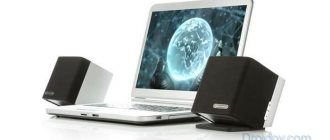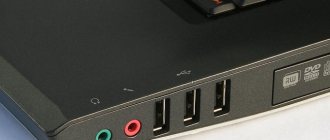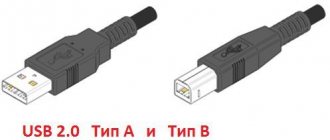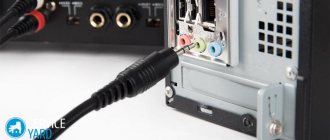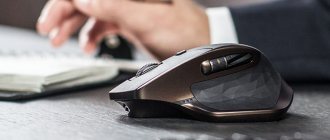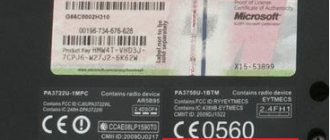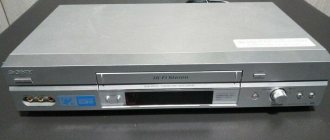Good day everyone!
Recently, wireless mice and keyboards have become quite popular.
On the one hand, this is very convenient: there are no extra wires on the table, the mouse slides freely in any direction, it is comfortable to use in “road” conditions; on the other hand: there are questions about the connection, plus they don’t always work until Windows boots (which is sometimes necessary).
I will build this article in the form of step-by-step instructions for connecting a standard wireless mouse (I will consider the two most common options: the so-called radio frequency mouse, and Bluetooth). I think the note will be useful to all novice users who have not yet used this type of mouse.
Now closer to the point.
Connecting a wireless mouse
RF (with adapter)
This mouse comes with a small adapter (looks like a flash drive). As a rule, the size of this adapter is very modest: after installing it in a USB port, the protruding part is barely noticeable (shown in the photographs below).
I would also note that, on average, mice in this category are cheaper than Bluetooth mice (today prices are comparable to classic wired ones).
I'll look at connecting it step by step.
STEP 1
And so, first check the contents: there should be the mouse itself, batteries and an adapter (see photo below). It is worth noting that batteries are not always included with the mouse (pay attention to this when purchasing!).
Note: 1) by the way, some novice users are faced with the fact that they cannot find the adapter. The fact is that sometimes it is located in the battery compartment (inside the mouse). Apparently, manufacturers do this so that it does not get lost.
2) Before you start connecting: disconnect your old mouse from the computer.
RF mouse contents
STEP 2
Turn the mouse over, open the battery compartment and install them (pay attention to the polarity).
STEP 3
Some mice are equipped with additional switch. Check that it is in the “ON” position (i.e. turned on). If you do not have such a switch, then the mouse, in principle, should start working immediately after installing the batteries.
Pay attention to the switch!
STEP 4
Connect the adapter to the USB port (after a few seconds you should hear a characteristic sound from Windows, which always happens when connecting USB devices).
Connecting the adapter to the USB port
STEP 5
Try moving the mouse, spinning the wheel, pressing the right/left buttons. As a rule, after 1-2 clicks the mouse should establish a connection and start working.
I note that some mice have a special feature. button for establishing a connection (sometimes it is combined with the “DPI” button. Located next to the wheel). If you have a similar button, click it.
In general, that's all. If everything is in order with the mouse, the batteries are new (and not yet empty) - then the mouse will start working. No extras. No settings are required.
STEP 6
If the pointer movement speed is too fast (slow), then you can go to the control panel (to do this, press Win + R and enter the control command), go to the “Hardware and Sound” section and open the mouse settings (see screenshot below).
Control Panel - Mouse
Next, in the “Pointer Parameters” section, set the pointer speed. In general, everything is standard.
Pointer speed
Bluetooth mouse
Bluetooth mice are less popular than previous ones. To use them, of course, you must have a Bluetooth adapter installed on your computer/laptop (usually all modern devices are equipped with it). Before setting up and connecting, I recommend checking whether Bluetooth is working for you (and turning it on if necessary).
Now, actually, to the point.
STEP 1
Go to Device Manager and see that the Bluetooth adapter is working fine and there are drivers for it (how to open Device Manager).
The device works fine (Bluetooth adapter)
STEP 2
Check if Bluetooth is enabled in Windows settings (some laptops have a special button on the device body).
If you have Windows 10, go to the OS settings (Win+i button combination), to the “Devices/Bluetooth and other devices” section and check that Bluetooth is turned on. For an example, see the screenshot below.
Is Bluetooth turned on (Windows 10)
Customizing the Mouse Wheel Control
Another parameter we can adjust when setting up a mouse is the wheel.
- Vertical scrolling - here you set the distance by which the page is scrolled when you scroll the wheel one notch. Either we set a specific number of lines, or the whole screen is static. This is convenient when reading documents, when you can turn an entire page at once with one movement.
- Horizontal scrolling - This feature is supported by some more sophisticated and expensive mice to move a certain number of characters horizontally.
How to connect an RF mouse
The first thing you need to do before connecting the mouse is to check its compatibility with the computer to which it will be connected.
There are 2 types of radio mice:
- connected to a 27 MHz USB receiver supplied with the mouse;
- connected to the 2.4 GHz USB Bluetooth receiver that came with the mouse, or to the Bluetooth module inside the laptop.
You can check the website or read the mouse packaging to make sure it is compatible with the operating system you will be connecting to.
Reference! Depending on the model of the radio frequency mouse, the connection may differ slightly, but its basic principles are almost the same for all radio mice.
Step 1. To make the connection, insert the receiving device (USB receiver), usually supplied with a wireless mouse, into the USB connector of the PC. Windows will automatically search for and install the required driver.
Step 2. Install batteries of the desired type into the wireless mouse, observing the polarity. On most models, you can lift the top panel of the mouse or open the lid on the bottom to reveal the battery compartment.
Important! Wireless mice typically use AA batteries to power them. If batteries are not included with the mouse, you will need to install new batteries that you purchased. If batteries are installed in the battery, they may need to be charged.
Step 3. Turn on the mouse. This usually requires pressing a button or moving a switch on the underside of the mouse. In the photo, the button is located on the top side of the platform.
Reference! If you find the power button or can't find it, you can refer to the manual that came with your mouse for any information you need.
Step 4. If possible, select the required channel with the button. Channel selection is required to connect the mouse to multiple PCs in a room.
Step 5. Connect the mouse to the receiving device. To do this, press and hold the device pairing button on the mouse. If necessary, also simultaneously press and hold the button on the USB receiver. Continue holding the buttons until the light on the underside of the mouse lights up or the indicator on the top of the mouse changes its glow.
Reference! Typically, after pairing, the mouse light will go from flashing to a steady light. Some wireless mice are plug-and-play and do not require these button pressing steps.
Step 6. Turn the mouse over, place it on a flat surface and start moving it, checking that it is connected correctly and the cursor is moving correctly. If the cursor moves normally, the device is connected.
Important! You should not use an optical mouse in rough, wet, dusty areas as this may reduce its tracking accuracy.
Wireless mouse: what is this device?
A wireless mouse is a device that appeared during the technical evolutionary process, having a similar purpose as a wired mouse, but connecting to a computer wirelessly.
Such a technological solution simplifies not only the process of connecting the device, but also gives the user more mobility when using the mouse. In computer parts stores you can find several types of wireless mice, differing in connection technology, which must be taken into account when choosing a mouse for your computer.
Principle of operation
Fundamentally, the functionality of a wireless mouse is absolutely no different from the operation of a conventional wired accessory, with the exception of the absence of wires that limit the distance of the mouse from the computer. The most important thing is to connect a wireless accessory to a laptop used in mobile conditions, which complicates the possibility of using wired units.
Depending on the type of accessory purchased, the principle of device synchronization varies. The most popular are mice that interface with a PC via Bluetooth connection, as well as radio frequency models, which come with a special USB receiver that receives a signal from the mouse by transmitting information via radio frequency channels. The least popular are induction mice, the principle of which is to transmit data from the mouse to a special tablet pad via induction pulses, and the mat, in turn, transmits a signal via a cable connected to the PC via a USB cable.
Diagram of how a mouse works with an optical sensor (left) and a laser sensor (right)
Range
The radius of the mouse's manipulation sensitivity is determined by the type and technical characteristics. If the purchased product is of the induction type, then the consumer should not count on a large range of action: the range of the accessory is determined by the length of the cord of the tablet mat.
RF models provide a stable signal at a distance of up to three meters, which is considered a good indicator for such a manipulator. The most reliable and resistant to interference are mice that work via data transmission via Bluetooth: their signal range can be up to ten meters.
How to Connect a Bluetooth Mouse on Mac OS X
Step 1: Open the Apple menu by selecting “System Preferences”.
Step 2. Click on the “Bluetooth” icon.
Step 3. In the menu that opens, click “Turn Bluetooth On”.
Step 4. Switch the gadget's power to the active state. If the connected device has a pairing button, activate it to put the device into this mode. Wait until the detected mouse appears on the right side of the window.
The mouse is ready to use.
Possible connection problems
As you can see, the process of connecting a mouse to a laptop is quite simple and even a novice user can do it. The main thing is that you have access to the Internet, and the system will configure everything itself.
But if suddenly the laptop does not find the necessary drivers, you will have to go to the manufacturer’s website yourself and install them manually. In the search engine, set the parameters of the mouse model, and in the results select the official website of the manufacturer. There, find the “Downloads” section and download the necessary drivers.
After this, the wired mouse needs to be pulled out of the USB port and inserted again, for the radio mouse, do the same with the adapter, and the Bluetooth mouse on the sole must be turned off and on again.
If you purchase a wireless controller with an adapter, you may experience problems receiving the Wi-Fi signal. This will only happen if the frequencies of the mouse and the wireless network match. In such a situation, a loss of Internet speed of up to 70% is possible. There is only one way out - to return to the old mouse with a cord. Such problems usually do not arise with a Bluetooth mouse.
Rules for connecting a wireless mouse to a laptop
When the mouse is not in use, to conserve battery power, it is recommended that you turn it off using the power off button on the mouse unless it has an automatic shutdown feature.
You can also set the mouse to turn off using Windows controls.
Step 1. Click “Start” and select “Control Panel” in the “Windows System” directory.
Step 2. Click on the “Mouse” icon.
Step 3. Select the “Hardware” tab and click “Properties”.
Step 4: In Mouse Properties, go to Power Management and select Allow the computer to turn off this device to save power by clicking OK.
Reference! When using a wireless mouse, it takes some time to detect it when the operating system starts, so it may not start working with the mouse right away, which is normal.
Mouse settings
To configure convenient settings, you will have to go to the Control Panel in the “Mouse” folder. For personal preference, change the button assignments if you are left-handed. You can also set the double-click speed and enable the sticky feature.
The “Equipment” tab will tell you about all the parameters. Some mice can be configured with multi-gestures.
In “Pointers” you can change the appearance of the cursor, in “Parameters” you can set the required speed of its movement, increased accuracy, and a shadow from the mouse. The “Wheel” tab is designed to configure the number of lines allowed to scroll per click and the tilt of the wheel.
Windows 7
So, in Windows 7 you need to left-click on the “Start” menu and go to the “Control Panel” section
Next, we arrange the display in the form of icons and find the “Mouse” section
Click on it and get into settings.
Windows 10
In Windows 10, right-click on the Start icon and select Settings
Next, go to “Devices”
and in the left column select “Mouse” and follow the link “Advanced mouse settings”
Further, all parameters are identical on all versions of Windows.
- In the first tab, you can mirror the button assignments - this is convenient to do if you are left-handed. That is, the functions of the right button will transfer to the left and vice versa.
- The next mouse setting is the double-click speed. The higher the speed, the faster you need to press the button to trigger a double click and, accordingly, to open files and folders. If you do not have time to do this quickly, then bet on a lower value.
- Sticky - when this function is enabled, a single click locks the mouse in the position in which it is currently located. Pressing it again releases it. That is, instead of holding the key down constantly, for example, to move a window or highlight text, you just need to click once, move it to the desired location, and click again to release.
To save the settings, you must click the “Apply” button
How to identify a malfunction?
If the mouse cursor does not move after connecting it, you can try turning the mouse off and on again. You can also try changing the USB port on your laptop into which the receiver (dongle) is inserted.
If this does not help, you need to refer to the “Problems” section of the manual supplied with the mouse to solve any problems that may arise.
If the mouse connects directly to your laptop, you can also try reinstalling the Bluetooth driver on it.
- Go to "Device Manager".
On a note! The correct connection of the RF mouse may also be interfered with by installed antivirus software, which can be disabled while it is running.
Video - How to connect a wireless mouse to a laptop
Did you like the article? Save so you don't lose!
A user can connect a wireless computer mouse to every relatively modern computer or laptop. We will tell you how to connect a wireless mouse via an adapter and Bluetooth, what settings you need to make in the operating system, possible problems, and ways to solve them.
Customizing the mouse cursor
If we go to the “Pointers” tab, we can configure the graphical display of the mouse cursor. If someone doesn’t like the standard ones, then other options are chosen here. Firstly, there are already several pre-installed sets from which you can choose a whole set of signs made in a single stylistic solution.
If you need to replace any individual pointer, then select the cursor from the list, and then click on the “Browse” button
Find the folder with cursors downloaded from the Internet with the extension .ani or .cur
select it and click on the “Open” button and then click on the “Apply” button.
How to change the mouse pointer
- Open mouse properties. To do this, click the Start
and select
Control Panel
.
In the search box, type mouse
and select
Mouse
. - Go to the tab Signposts
and do one of the following:
- To change the appearance of all pointers, in the drop-down list Scheme
select a new scheme.
- To change an individual pointer, in a list Settings
select the index, click the
Browse
, select the index you want, and click the
Open
.
- To change the appearance of all pointers, in the drop-down list Scheme
- Click the button OK
.
How to customize your mouse pointer
- Open mouse properties. To do this, click the Start
and select
Control Panel
.
In the search box, type mouse
and select
Mouse
. - Go to the tab Pointer Options
and do any of the following:
- To change the pointer speed, see Moving
Move the
Set pointer speed slider
to
Lower
or
Higher
. - To make the pointer work more accurately when moving the mouse slowly, see Moving
Select the
Enable enhanced pointer precision check
. - To speed up the selection of items in the dialog box, in the section Home position in dialog box
Select the
On the default button check
. (Not all programs support this option. Some programs require you to move the mouse pointer to the desired button.) - To make the pointer more visible when moving, in the section Visibility
Select the
Show mouse trail check
and drag the slider to
Shorter
or
Longer
to make the mouse trail smaller or larger. - To prevent the pointer from getting in the way when entering text, in the section Visibility
Select the
Hide pointer while typing check box
. - So that the index can be found by pressing the Ctrl key in the section Visibility
Select
the Indicate pointer location when pressing CTRL check
.
- To change the pointer speed, see Moving
- Click the button OK
.
Instructions for connecting via adapter
The vast majority of wireless computer mice are connected to a laptop or computer via an adapter. The signal is transmitted via the Wi-Fi protocol from the device to the adapter and then processed by the computer. The maximum operating range is usually 15 meters. Next, we will describe in detail how to connect a wireless computer mouse to a laptop. The instructions provided will also be relevant for those who are interested in how to connect a wireless mouse to a personal computer.
Manipulating the mouse and adapter
If you have a wireless mouse, the first thing you need to do is find and connect the adapter. Typically, it comes in a box with the product itself or is hidden inside the mouse body. It is usually located in a special recess or compartment on the back of the mouse.
Connect a wireless radio mouse via a USB adapter
After connecting, Windows should install the drivers. I have already connected many wireless mice, and I have never encountered a problem when Windows cannot find or install the required driver. If it happens that the system does not recognize the device, then you can try downloading the driver or software from the manufacturer’s website. We write in the search the name and model of our mouse. For example, “Logitech M185” and in the search results we go to the official Logitech website. There we already look for the downloads section and download the necessary driver. But you probably won't have to do this.
After this, the mouse should work immediately. If it turns out that after connecting the wireless mouse does not work, then first of all:
In most cases, these devices connect and work without any problems at all. Especially in Windows 10, Windows 8, Windows 7.
Connection via Bluetooth
Next, we will tell you how to connect a wireless mouse to a laptop via Bluetooth. To do this, your laptop or computer must have the appropriate module. Most laptops have such modules installed from the factory. To connect a wireless mouse to your computer, follow these steps:
- Go to the Bluetooth section. In the program bar in the lower right corner, right-click on the corresponding icon.
- Select "Add device".
- The system will search for all devices. Among those found, naturally, click on your wireless mouse and click “Next”.
- In the connection type, select the last item labeled “Pairing without code.” Click Next.
- Wait until the device setup is completed.
In Windows 10, users can activate search through the main menu. Click on “Start”, select “Settings” -> “Devices”. Move the Bluetooth enable slider to the active state, and select the required devices in the found devices window.
Summarizing
Wireless type mice are a convenient and mobile alternative to conventional “tailed” manipulators, however, so that the result does not disappoint immediately after purchasing the product, it is better to give preference to models from well-known manufacturers with good technical characteristics.
When choosing a mouse, you should pay attention to the type of connection, which will determine the ability to synchronize the selected product with a personal computer device, as well as focus on the range.
Possible problems and solutions
Wireless equipment may not connect for a variety of reasons, from incorrectly installed drivers to defects. We recommend the following setup steps:
- turn the mouse on and off several times and then check again;
- check if the battery is charged;
- Check the functionality of the USB port into which the adapter is installed (try connecting another device to it).
- make sure the bluetooth module is working properly (connect your phone or tablet to your laptop);
- install the driver (be sure to restart your computer after this);
- Make sure that the operation of the wireless adapter or Bluetooth module is not blocked by administrator rights or other software (antivirus).
Some hardware problems can be solved with specialized software, for example, MS Fix IT or Connection Tools. After launch, the program prompts the user to check the system for the absence or presence of malfunctions. The software will scan. If problems are detected, a window will appear asking you to fix them. Before answering positively, carefully read what exactly the program will correct.
Now you know all the troubleshooting methods. Having solved them, you will be able to freely use a wireless mouse. If the described methods do not help, take the mouse to the purchase store and present your claims about its inoperability (if the product is under warranty). Alternative options are to take the device to a service center or simply buy a new mouse.
How to change mouse button functions
- Open mouse properties. To do this, click the Start
and select
Control Panel
.
In the search box, type mouse
and select
Mouse
. - Go to the tab Mouse buttons
and do any of the following:
- To change the functions of the right and left mouse buttons, in the section Button Configuration
Select the
Swap button assignments
. - To change the double-click speed, see Double click speed
Move the
Speed
to
Lower
or
Higher
. - To enable sticky mouse button, which allows you to select or drag items without holding down the mouse button, in the section Mouse Button Stuck
Select the
Enable Sticky check
.
- To change the functions of the right and left mouse buttons, in the section Button Configuration
- Click the button OK
.
How to connect a wired mouse to a laptop
To do this, there is a USB connector in the laptop, to which the mouse is connected, just like a flash drive, phone data cable, etc.
REFERENCE! Some users use older models with a PS/2 connector, for which you must additionally purchase a USB adapter with the appropriate input.
A few seconds after connection, driver installation starts automatically. As a rule, it does not last long, so you just have to wait for it to end. Most often, this installation occurs only once, during the first connection; in the future it will not be required, since all the necessary components are already downloaded.
ATTENTION! If the laser LED on the mouse is working and the cursor is not moving, restarting the laptop may help. If this does not work, try connecting the device to a different USB port.
